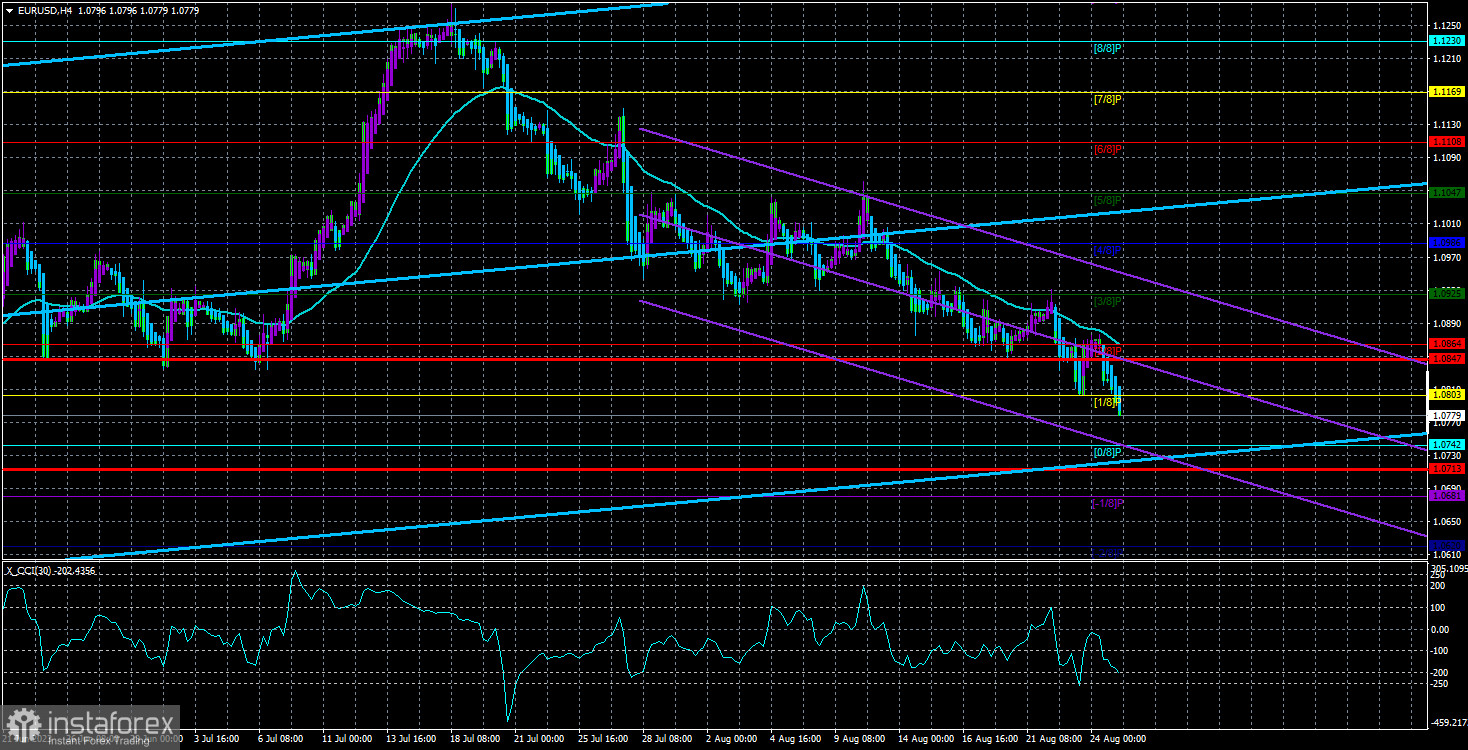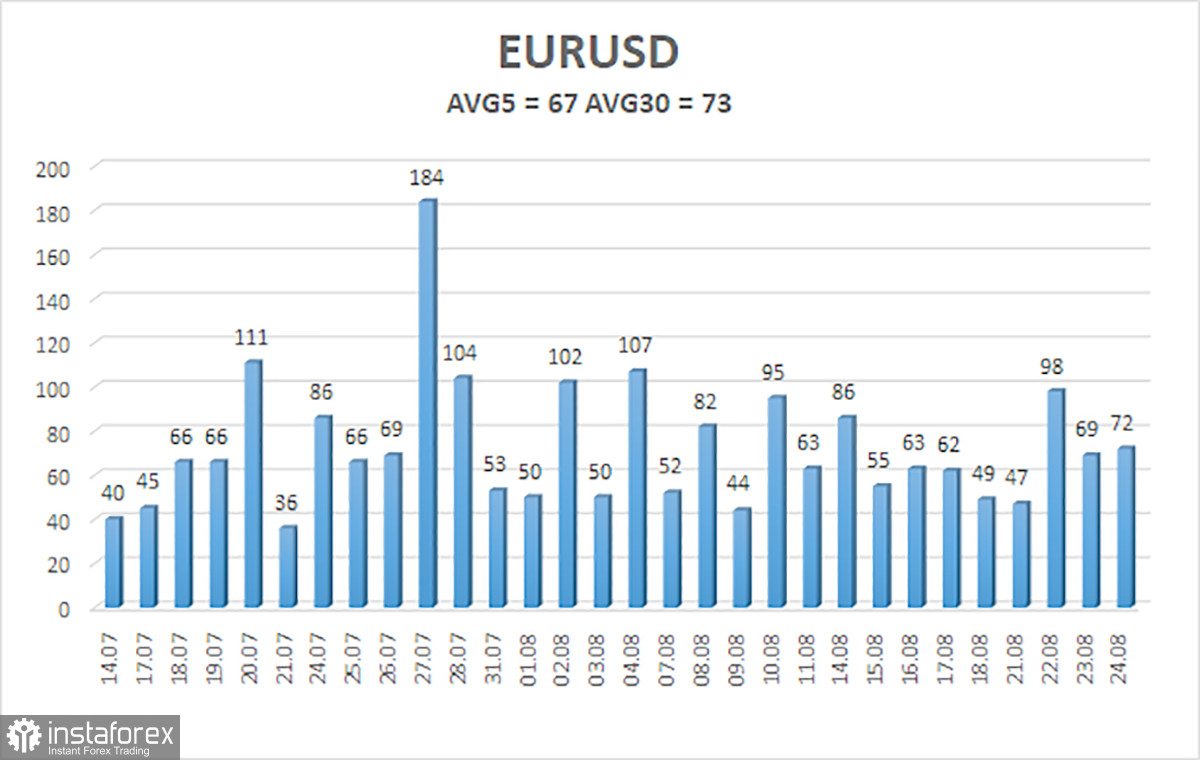
The EUR/USD currency pair continued its tepid and not overly strong decline throughout the past day. Over recent weeks, we have repeatedly said that we anticipated this type of movement; therefore, everything is going according to plan. The European currency remains extremely overbought, and all its growth factors have been exhausted for a long time. Hence, we see only one direction for the pair - downward. It should be noted that, as of now, the euro has depreciated from its annual highs by merely 500 points. While this is significant, the 24-hour timeframe suggests that the current correction can hardly even be called a "correction"; it's more of a pullback. Therefore, we expect a more substantial fall in the European currency.
Notably, the pair had been falling throughout the previous day and night. During the day, no unequivocal events or reports favored the US dollar. Therefore, the market was not selling based on macroeconomic or fundamental backgrounds. There was no news at night, but the European currency continued its decline. From our perspective, this indicates a shift to a downward trend. If so, one can only expect a drop in the euro.
What's puzzling now is the oversold status of the CCI indicator. Typically, these are strong buy signals, but growth may not begin on the first try and might occur after the second or third entry into the oversold zone. One way or another, upward corrections have not been ruled out. Even today, we might witness a rise in the European currency, after which another decline should follow.
There's little hope placed in Christine Lagarde.
This week, we've witnessed numerous interesting reports. Topping the list in terms of resonance are the business activity indices in the European Union. Let's recall that the manufacturing sector has been below the "waterline" for quite some time, and the service sector declined below it in August. This should be a wake-up call for the ECB that the economy continues to face serious challenges despite tightening monetary policy. In simpler terms, the worse the macroeconomic indicators fare, the higher the likelihood of ending the tightening cycle soon.
At the Jackson Hole symposium, Jerome Powell and Christine Lagarde will speak today. We expect the ECB head to speak about a pause in tightening at the next meeting. The ECB is nearing its peak rate value, and the heads of some EU central banks have already started talking about the imminent end of rate hikes. It should be noted that historically, the ECB hasn't raised its rate too high. If the USA or the UK are large countries with strong economies, the EU is a consortium of nations where each country's state must be considered. Consequently, countries with weaker economies can't withstand a rate pressure of 5% or 6%. Thus, the ECB has to balance the interests of stronger and weaker countries. Based on this fact, we assume the tightening will end in the upcoming sessions. If this is correct, Christine Lagarde may hint at it today. The market will perceive such rhetoric as "dovish," putting additional pressure on the euro. However, will the market believe her even if Lagarde adopts a "hawkish" stance? After all, the euro has been declining for over a month (and should decline much longer and more significantly).

The average volatility of the EUR/USD currency pair over the last five trading days as of August 25th is 67 points and is characterized as "medium." Thus, we expect the pair to move between the levels of 1.0713 and 1.0847 on Friday. The reversal of the Heiken Ashi indicator suggests a new upward correction.
Nearby support levels:
- S1 – 1.0742
- S2 – 1.0681
- S3 – 1.0620
Nearby resistance levels:
- R1 – 1.0803
- R2 – 1.0864
- R3 – 1.0925
Trade recommendations:
The EUR/USD pair currently maintains a downward trend. It's advisable to stay in short positions with targets of 1.0742 and 1.0713 until the Heiken Ashi indicator reverses upwards. Long positions can be considered if the price consolidates above the moving average line, with targets at 1.0925 and 1.0986.
Explanations for illustrations:
- Linear regression channels help determine the current trend. The trend is currently strong if both are pointed in the same direction.
- Moving average line (settings 20,0, smoothed) determines the short-term trend and the current trading direction.
- Murray levels are target levels for movements and corrections.
- Volatility levels (red lines) are the probable price channel in which the pair will operate in the next 24 hours based on current volatility indicators.
- When entering the oversold area (below -250) or overbought area (above +250), the CCI indicator indicates an impending trend reversal in the opposite direction.
 English
English 
 Русский
Русский Bahasa Indonesia
Bahasa Indonesia Bahasa Malay
Bahasa Malay ไทย
ไทย Español
Español Deutsch
Deutsch Български
Български Français
Français Tiếng Việt
Tiếng Việt 中文
中文 বাংলা
বাংলা हिन्दी
हिन्दी Čeština
Čeština Українська
Українська Română
Română

